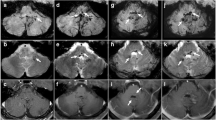Abstract
Lhermitte-Duclos Disease (LDD) is a rare cerebellar lesion that has long been controversial as to whether the entity is a hamartoma, a malformation, or a neoplasm. Recent advances in metabolic imaging and molecular biology have unveiled biological features of LDD and a close relationship between LDD and Cowden disease. Adult onset LDD is now considered identical to Cowden disease in a US guideline. We present a case of LDD, in which high fluorodeoxy glucose (FDG) uptake was shown on PET/CT. We performed dual time point scans, in which a delayed scan exhibited more intense FDG uptake by the hamartomatous lesion than an early scan. We must remain aware of the possibility of LDD when intense accumulation is observed in a cerebellar lesion on FDG-PET/CT imaging.



Similar content being viewed by others
References
Cowden syndrome. National Comprehensive Cancer Network (NCCN) Clinical Practice Guidelines in Oncology, version 1.2006 http://www.nccn.org/professionals/physician_gls/PDF/genetics_screening.pdf
Vantomme N, Van Calenbergh F, Goffin J, Sciot R, Demaerel P, Plets C (2001) Lhermitte-Duclos disease is a clinical manifestation of Cowden’s syndrome. Surg Neurol 56:201–204
Robinson S, Cohen AR (2006) Cowden disease and Lhermitte-Duclos disease: an update. Case report and review of the literature. Neurosurg Focus 20:E6
Lhermitte J, Duclos P (1920) Sur un ganglioneurome diffus du cortex du cervelet. Bull Assoc Fr Etude Cancer 9:99–107
Nelen MR, Padberg GW, Peeters EA, Lin AY, van den Helm B, Frants RR, Coulon V, Goldstein AM, van Reen MM, Easton DF, Eeles RA, Hodgsen S, Mulvihill JJ, Murday VA, Tucker MA, Mariman EC, Starink TM, Ponder BA, Ropers HH, Kremer H, Longy M, Eng C (1996) Localization of the gene for Cowden disease to chromosome 10q22–23. Nat Genet 13:114–116
Meltzer CC, Smirniotopoulos JG, Jones RV (1995) The striated cerebellum: an MR imaging sign in Lhermitte-Duclos disease (dysplastic gangliocytoma). Radiology 194:699–703
Awwad EE, Levy E, Martin DS, Merenda GO (1995) Atypical MR appearance of Lhermitte-Duclos disease with contrast enhancement. AJNR Am J Neuroradiol 16:1719–1720
Ortiz O, Bloomfield S, Schochet S (1995) Vascular contrast enhancement in Lhermitte-Duclos disease: case report. Neuroradiology 37:545–548
Padma MV, Jacobs M, Sequeira P, Adineh M, Satter M, Kraus G, Mantil JC (2004) Functional imaging in Lhermitte-Duclose disease. Mol Imaging Biol 6:319–323
Klisch J, Juengling F, Spreer J, Koch D, Thiel T, Buchert M, Arnold S, Feuerhake F, Schumacher M (2001) Lhermitte-Duclos disease: assessment with MR imaging, positron emission tomography, single-photon emission CT, and MR spectroscopy. AJNR Am J Neuroradiol 22:824–830
Fulham MJ, Melisi JW, Nishimiya J, Dwyer AJ, Di Chiro G (1993) Neuroimaging of juvenile pilocytic astrocytomas: an enigma. Radiology 189:221–225
Hustinx R, Smith RJ, Benard F, Rosenthal DI, Machtay M, Farber LA, Alavi A (1999) Dual time point fluorine-18 fluorodeoxyglucose positron emission tomography: a potential method to differentiate malignancy from inflammation and normal tissue in the head and neck. Eur J Nucl Med 26:1345–1348
Kubota K, Itoh M, Ozaki K, Ono S, Tashiro M, Yamaguchi K, Akaizawa T, Yamada K, Fukuda H (2001) Advantage of delayed whole-body FDG-PET imaging for tumour detection. Eur J Nucl Med 28:696–703
Zhuang H, Pourdehnad M, Lambright ES, Yamamoto AJ, Lanuti M, Li P, Mozley PD, Rossman MD, Albelda SM, Alavi A (2001) Dual time point 18F-FDG PET imaging for differentiating malignant from inflammatory processes. J Nucl Med 42:1412–1417
Author information
Authors and Affiliations
Corresponding author
Rights and permissions
About this article
Cite this article
Nakagawa, T., Maeda, M., Kato, M. et al. A case of Lhermitte-Duclos disease presenting high FDG uptake on FDG-PET/CT. J Neurooncol 84, 185–188 (2007). https://doi.org/10.1007/s11060-007-9355-x
Received:
Accepted:
Published:
Issue Date:
DOI: https://doi.org/10.1007/s11060-007-9355-x




